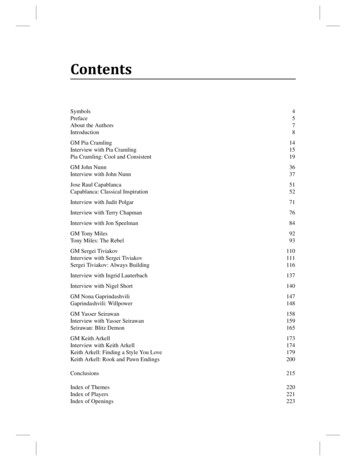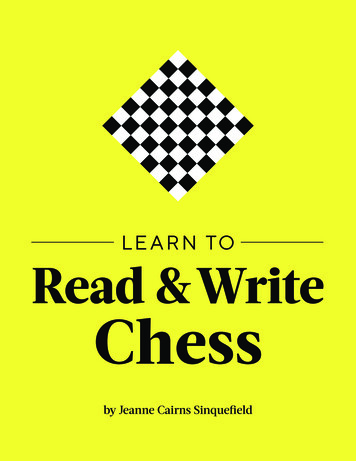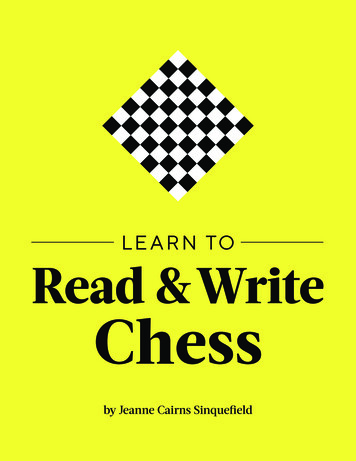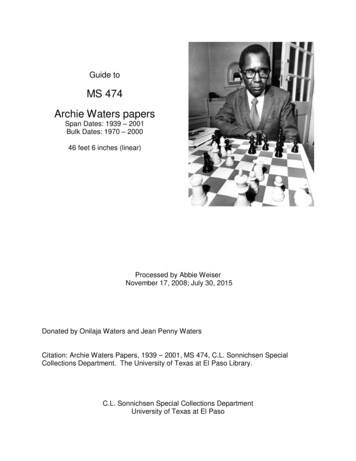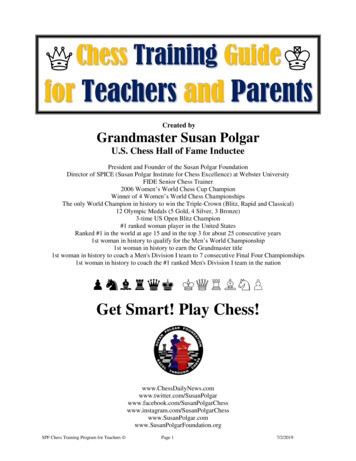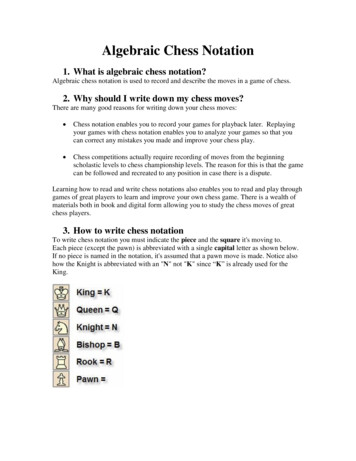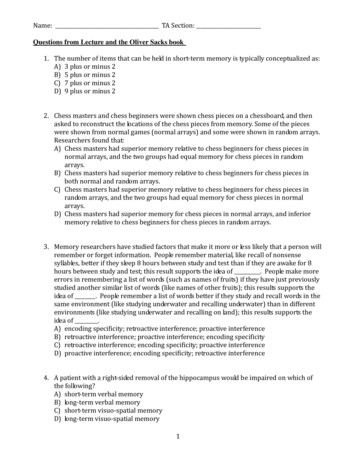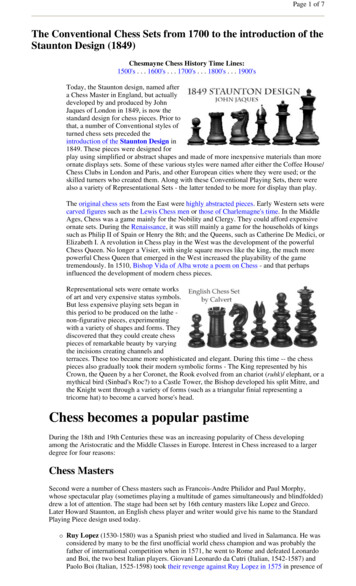
Transcription
Page 1 of 7The Conventional Chess Sets from 1700 to the introduction of theStaunton Design (1849)Chesmayne Chess History Time Lines:1500's . . . 1600's . . . 1700's . . . 1800's . . . 1900'sToday, the Staunton design, named aftera Chess Master in England, but actuallydeveloped by and produced by JohnJaques of London in 1849, is now thestandard design for chess pieces. Prior tothat, a number of Conventional styles ofturned chess sets preceded theintroduction of the Staunton Design in1849. These pieces were designed forplay using simplified or abstract shapes and made of more inexpensive materials than moreornate displays sets. Some of these various styles were named after either the Coffee House/Chess Clubs in London and Paris, and other European cities where they were used; or theskilled turners who created them. Along with these Conventional Playing Sets, there werealso a variety of Representational Sets - the latter tended to be more for display than play.The original chess sets from the East were highly abstracted pieces. Early Western sets werecarved figures such as the Lewis Chess men or those of Charlemagne's time. In the MiddleAges, Chess was a game mainly for the Nobility and Clergy. They could afford expensiveornate sets. During the Renaissance, it was still mainly a game for the households of kingssuch as Philip II of Spain or Henry the 8th; and the Queens, such as Catherine De Medici, orElizabeth I. A revolution in Chess play in the West was the development of the powerfulChess Queen. No longer a Visier, with single square moves like the king, the much morepowerful Chess Queen that emerged in the West increased the playability of the gametremendously. In 1510, Bishop Vida of Alba wrote a poem on Chess - and that perhapsinfluenced the development of modern chess pieces.Representational sets were ornate worksof art and very expensive status symbols.But less expensive playing sets began inthis period to be produced on the lathe non-figurative pieces, experimentingwith a variety of shapes and forms. Theydiscovered that they could create chesspieces of remarkable beauty by varyingthe incisions creating channels andterraces. These too became more sophisticated and elegant. During this time -- the chesspieces also gradually took their modern symbolic forms - The King represented by hisCrown, the Queen by a her Coronet, the Rook evolved from an chariot (ruhk)/ elephant, or amythical bird (Sinbad's Roc?) to a Castle Tower, the Bishop developed his split Mitre, andthe Knight went through a variety of forms (such as a triangular finial representing atricorne hat) to become a carved horse's head.Chess becomes a popular pastimeDuring the 18th and 19th Centuries these was an increasing popularity of Chess developingamong the Aristocratic and the Middle Classes in Europe. Interest in Chess increased to a largerdegree for four reasons:Chess MastersSecond were a number of Chess masters such as Francois-Andre Philidor and Paul Morphy,whose spectacular play (sometimes playing a multitude of games simultaneously and blindfolded)drew a lot of attention. The stage had been set by 16th century masters like Lopez and Greco.Later Howard Staunton, an English chess player and writer would give his name to the StandardPlaying Piece design used today.{Ruy Lopez (1530-1580) was a Spanish priest who studied and lived in Salamanca. He wasconsidered by many to be the first unofficial world chess champion and was probably thefather of international competition when in 1571, he went to Rome and defeated Leonardoand Boi, the two best Italian players. Giovani Leonardo da Cutri (Italian, 1542-1587) andPaolo Boi (Italian, 1525-1598) took their revenge against Ruy Lopez in 1575 in presence of
Page 2 of 7King Felipe II. His name lives on in both a popular chess opening, as well in the Chessbook he wrote in 1561. His opening, generally known as the Spanish Opening, but manyEnglish players call it the Ruy López is one of the most famous of all openings. It goes 1.e4e5 2.Nf3 Nc6 3.Bb5.{Gioachino Greco (Italy, 1600-1634) An Italian player of note who wrote a book The RoyalGame of Chess Play on Chess Traps and Gambits. Whether he actually played these 77games or made them up is debated, but they are brilliant. Nicknamed "il Calabrese", he wasconsidered the best player of the 17th Century.{François André Danican Philidor (France, 1726-1795) Foralmost 50 years, Philidor was the unofficial chess champion of theworld. Philidor spent much of his time in the Chess clubs of Parisand London. He first came to the chess world's attention when hebeat Philip Stamma in a 10 games series at Slaughter's CoffeeHouse at the age of 21. He maintained his reputation by winningmatch after match in Parisian cafes, beating famous philosophers ofthe time such as Jean-Jacques Rousseau and Francois Voltaire. Thebest player of the 18th century, he often drew crowds to the chessclubs in Paris and London with demonstrations of playingblindfolded while playing multiple games. He was also a composer, and wrote 20 operas,including one on Tom Jones, based on Fielding's novel. In December 1792, at age 65, heleft France for England, never to return. His music was banned from France after the FrenchRevolution (1789-1799) for political reasons. He had to leave his wife and children behind.later outstanding french players included Alexandre Deschappelles, 1815-20,Louis de laBourdonnais, 1820-40 and Pierre Charles Fournier de Saint Amant (1800-1872).Howard Staunton (England, 1810-1874) who created a storm of interestin chess in London. He was also writer with a particular interest inShakespearean literature. For thirty years Staunton was the best player inEngland, though he is probably remembered more today for refusing toplay Paul Morphy, than for His games. He promoted the idea of Chess byTelegraph - a form of correspondance chess. In February 1845, Stauntonbecame the chess columnist for the Illustrated London News. He was acolumnist for 29 years, until he died in 1874. The Chess-Player'sHandbook first appeared in 1847, and in 1848 he published the ChessPlayer's Companion. His endorsement of the Chess piece design of JohnJaques that still today bears his name helped make it successful - and for a fee, permitted afacsimile of his signature to be included with every “authentic” set.{{Paul Morphy (American 1837-1884) was an American protegy fromLouisiana. Morphy's first notable triumph came in 1857 as he won theFirst American Chess Congress with a dominating performance. Thissuccess was followed by a European trip where Morphy met anddefeated most of the prominent masters of the period includingLowenthal, Harrwitz, and Anderssen within a space of six months,however he never was able to play a match against Howard Staunton,the current world champion, who considered him a "professional chessplayer," but was probably afraid he would be routed. Returning to theStates, he quit playing chess in 1859 after in his twenties, supposablybecause a young woman rebuffed his advances "because he was only a chess player"!! .Many of his Games are recorded. he was also a master of blindfolded chess, once taking oneight opponents simultaneously in Paris. Bobby Fischer considered him the greatest playerof all time.Chess BooksThe books written by these masters did much to increase popular interest in the game.{ The Chess book by Ruy Lopez, a well know Spanish cleric and master chess playercontributed much to the interest in chess. A priest and master player, Ruy Lopez wrote hisBook of the Liberal Invention and Art of Playing Chess in Spain in 1561. His name lives onin a popular chess opening.{ Gustavus Selenus' book Chess or the King Game was written in 1616 and is mostsignificant for illustrating his book (essentially that of Ruy Lopez) with illustrations ofCentral European and German chessmen - what would be called the "SelenusStyle." (Actually Selenus was Augustus, Duke of Brunswick-Luneburg (1579-1666.){ Phillip Stamma (1705-?) was considered as the leading chess player in England. He was aSyrian chess player from Allepo and an interpreter of Oriental languages. His Noble Gameof Chess (Essai sur le jeu des Echecswas written in French in 1737 and translated intoEnglish 1745, as well as German and Dutch.) A book of chess problems, it had 74 openingsand 100 end games. Stamma is considered the pioneer of modern Chess technique. Stamma
Page 3 of 7{{divided his time between London and Paris. Not much is known about him. He ws defeatedby Philidor in a ten game tournament (8-1, 1 draw) in 1747 at Slaughter's Coffee-House inLondon.Francois-Andre Philidor Analyse du jeu des echecs (1749). His book, emphasizing theplay of pawns was for people who knew the basic game and wanted more. This was the firstchess book that organized the chess openings. It was a favorite of Thomas Jefferson.Ben Franklin wrote an Article on the Morals of ChessCoffee Houses and Chess ClubsA third source of growing popularity of Chess began in the Coffee Houses in majorEuropean cities, such as the Cafe de la Regence "Place du Palais-Royal" in Paris, justbeside the Louvre; and Slaughter's Coffee House and Parsloe's in London, where chessattracted many players. The Cafe de la Regence attracted players like Voltaire, Rousseau,Stamma and Philidor, Ben Franklin, Robespierre, Napoleon, Harrwitz, and Morphy. Othercoffee houses noted for chess play included the Roode Leeuw in Amsterdam; the Bauer,Belvedere, and Konig in Berlin; the Cafe de la Couronne in Geneva; the Cafe du Levant inMadrid; the International in New York; the Palazzo de’ Cinque in Rome; the Rabel andCentral in Vienna. These establishments contributed greatly to the increasing popularity ofchess, especially among the gentile classes. Visitors would usually obtain an opponent byapplying at the counter for an introduction. Playing for money stakes was discouraged, buthappened anyway - and there were a number of "professional" chess players hangingaround. They were on the lookout for rich opponents, and like professional gamblers wouldoften cede games to their opponents deliberately and praise their natural talents to keepthem interested while dipping into their pockets.The coffee-house epoch in the history of chess in England ended in the year 1810 with theestablishment of the London Chess club, where members met for play in a private room inCornhill. Other London Chess Clubs followed. The clubs were a place for gentlemen tomeet and play, maintaining decorum while keeping out the charlatans. They also helpedcodify the playing rules and sponsored championship tournaments. It was not until the year1832, that a rival association appeared upon the scene, the famous Westminster ChessClub where Howard Staunton, for many years the champion chess-player of England, madehis first appearance. The club was temporarily dissolved in 1835, again in 1840, but oncemore revived by Staunton, and the meetings were held in Charles-street, off the Haymarket,but it closed in 1843. In 1843, a new chess club at the West-end was formed, at BeattiesHotel, George-street, Cavendish-square, and was called after the name of the street in whichits first meetings were held, the St. George’s Chess Club. Beattie’s Hotel was closed in thefollowing year, and the St. George’s removed to new quarters at the Polytechnic. Here wasplayed the first International Chess Tournament in 1851. In the year 1857, after severalmoves, the St. George’s removed to its present quarters, Palace-chambers, King-street, St.James’s. In 1852, a club was formed in the city, under the title of the City of London ChessClub, by a few amateurs of little note at the time. This association is now, in point ofnumbers, and the chess force and public repute of its members, the strongest chess club inthe world. Daniel Harrwitz was a great favourite at the London and St. George’s Clubs,where for some years he had lucrative engagements.Chess Sets for Play{The final reason for the increased popularity of chess was the availability of quality andrelatively mass produced Conventional Chess sets, some of which were made by anumber of master carvers and turners. Many of the pieces were turned on lathes andassembled. Using now available materials - bone, hardwoods like boxwood, mahogony orebony, or soft woods like fruitwood. and the increased availability of Ivory - attractive andgenerally affordable sets discovered a substantial market. Ivory or bone white pieces wereleft as they were, the dark pieces were stained red, or possibly black. Wood black pieceswere stained a darker brown. In Germany skilled designs were published by Selenus andEdel, but more significant in the development of these beautiful conventional chess pieceswere the skilled English wood and ivory turners, such as John Calvert, the Lunds, GeorgeMerrifield, and John Jaques.The Conventional Designs
Page 4 of 7Certainly a key component to successful chess pieces design is recognition. Players needed to beable to readily tell the pieces apart. With quite a variety of sets in use, a lack of familiarity with achess set would put a player at a disadvantage as well. There were certain "conventions" to themaking of Chess pieces. Generally Kings and Queens were the tallest, often having a symbolicreference to a crown. Bishops, Knights and Rooks were simliar in height to each other anddistinguished by various symbols. Pawns were smaller and simpler. Sometimes there wasdifficulty with some Conventional sets telling thepieces apart as you can see from the illustrations onthe page. It would be this factor that wouldultimately lead to the development of the StauntonStyle by Nathaniel Cook. The Conventional setswere also tall and had a tendency to tip over, adefinate incovenience during moments of excitingplay especially.Politics also played its' part in the development of chess pieces. The Jacobean Style in the 1700'shad three crowns on the King reflecting perhaps their allegiance to the Pope. In France as well asAmerica, revolutionary feelings downplayed the "royalty" of the Kings and Queens. And therewas a lengthy period of conflicts especially between the English and French, but also in Easternand Northern Europe as well.The most popular conventional designs in Western Europe and America were the FrenchRegency; and the English Barleycorn, and St. George patterns. But a wide variety of interestingshapes and styles were in use during this time period.France and AmericaThe Regency design was named after Café de laRegence in Paris. Benjamin Franklin and ThomasJefferson were known to play there, as well asRobespierre and Napoleon.The Regency pieces were produced in the late 1700's till1890's. Earlier or more inexpensive sets had Knightswithout the traditional horse head, but rather turnedpieces with notched collars to distinguish them from theBishops. Latter sets had the more traditional horse head for the knight.Other pieces in use in France: The Lyon Chess sets added stylized ivory decorations to the simpler Regency set. Also found in use in French chess circles were the Representational Dieppe Chesssets which featured head and shoulders' busts mounted on pedestals. Dieppe is a townin France where an ivory carving industry thrived during the 18th century. Chess setsof intricately carved ivory were a product of Dieppe, usually depicting Frenchcharacters. The bishop was often depicted by a fool rather than a cleric. Following theFrench Revolution, "kingless" designs were developed in France and certainly this"revolutionary spirit" had an influence in the America's as well. Later Napoleon, whohad a nasty temper when he lost a game, would inspire a number of representationalsets, as would the battles he fought. The "head and shoulders style" persists in avariety of modern sets based on historical characters, and in the sculpted plastic orceramic Peter Ganine charicatured pieces popular in the 1960's.In the America's, Chess was popular among the Founding Fathers, perhaps in part fromtheir alliances with the French and the time that Franklin and Jefferson spent in France asambassadors. Conventional Sets belonging to Washington, Franklin and Jefferson are stillaround.Ben Franklin had a chess set of the French"Regency" design, as well as a miniatureivory set. Washington had an ivory chessset, and Jefferson had at least a half dozenchess sets, and has made quite a fewrefereneces to chess in his writings. Onebeautiful set of carved ivory Dieppe bustswas presented to him by the Frenchgovernment, but it was missing the kings,as legend has it, because the French didn't want to offend a man who had worked sohard to rid America of kings. Jefferson, an intellectual who could read the GreekClassics in Greek, had every chess book available in his time in the MonticelloLibrary. He also had a conventional English "Barleycorn" bone chess set, and the
Page 5 of 7design was growing in popularity, almost becoming a standard before the Stauntonstyle emerged. Benjamin Franklin was an enthusiastic player, and would write thefirst chess article published in the US, on "The Morals of Chess".A game of chess even contributed to the success of the American Revolution Washington's victory in crossing the Delaware at Trenton succeeded in part because anote warning of the attack from an English Sympathizer was pocketed unread whilethe officer, Colonal Johann Rall, finished his game of chess. The note was found inhis pocket, still unopened, when he died in battle.German and Eastern EuropeansetsIn Germany, chess sets were produced for theAristocracy and had a number ofdistinguishing characteristics. FollowingEastern European custom, frequently thefinials of the royal pieces would be in thecolors of the opposing pieces, and sometimes other portions of the pieces would be as well.Modern wooden sets from Poland and Russian often continue this tradition and they oftenhave multi-colored, woodburned, or carved decoration as well. Lovely carved and paintedrepresentational sets are often sold to tourists or exported today based on historicalcharacters and conflicts as well. Many of these sets are available on Ebay - try a search for"Chess set Polish wooden" or "Chess set Russian wooden".{The "Selenus Style" or Garden Style is the most elegant classical chess style. These sets,had elegant lathe turned bases and shafts and tiers with circlets resembling crowns. Pieceswere distinguished by heights, the number of tiers and sometimes by symbols. Sometimescalled "Garden Sets" - their theme was of "formal flower gardens" - Kings and Queens wereFountains; Bishops and Pawns were flowers; Knights were gentle horses; and Rooksbecame civic towers in stead of battlements. In England they were called "Tulip Sets." Michael Edel of Munich published a set of patternsin the early 1800's. Notable in his designs, was theconvention that a slanted straight edge would rest oneach the decreasing heights of the tops of the piecesfrom the King down to the pawn. He also replacedthe Castle with a Bell Tower with a cupola. In Hanover, the distinctive German Twin Knightappeared in 1743. German figural sets oftenreflected the conflict between the Habsburgs and theTurks (Ottomans). Carvers in the Tyrols and Augsburg produced fine representationalsets, frequently using fruitwood. Northern Europe also had a distinctive conventionalset - whose origin from either the Dutch, Danes or Germans is unclear.Early English SetsThe English Playing sets came in a variety of shapes, but all are finely turned andextremely well carved. The Queens frequently have a ball for a crown and the Rooksoften have flags or poles. Bone and Ivory was popular, but they also used hardwoodsas well. Red and White were the most popular colors in England. One of the first chess piece designscame from John Calvert in 1790.The king and queen had openworkcrowns, the bishop had a deepclefted mitre, and the rook was atower on a pedestal. He produced hischess sets at his shop at 189, FleetStreet from 1790 to 1840. Todaythey are collector's items. JohnCalvert also was originator of the St. George Design. The St. George design was named after a Chess Club in London. This was astandard design in Britain until the 1850's when it was almost universally replaced bythe Staunton sets. They were popular because they were cheap and easy to make as,all but the horses heads, could be turned on a lathe, giving the pieces their distinctive"stack of rounded disks" shape. They were mainly produced in France, but were notused a great deal there. The main fault with this design was the difficulty ofidentifying the pieces as they were all so similar. Only the Knights heads were reallydistinctive.
Page 6 of 7 The second most popular English style were the English Barleycorn sets especiallyin America. Made circa 1820 to 1845, the Barleycorn sets usually came in red-stainedand natural bone. The Rooks usually have a full tower with flag, and the Kings andQueens usually have elaborate decorative carvings on the barrels. The name"Barleycorn" comes from the style of decoration carved on the barrels of the Kingand Queen. The knights are well-carved and the bishops have the vertical split miter. Edinburgh (Northern Upright) pattern sets, circa 1840 to 1860, were available inred-stained and natural ivory or boxwood and ebony. The Sets are characterized bythe tall posts on each of the pieces. The pieces are exquisitely turned with attractivelycarved Knights, identical in style to those found in the better St. George style sets.The Northern Upright pattern is believed to contributed inspiration for the Stauntondesign and is quite rare. Lund pattern sets, Made by William andThomas Lund, early 1800's, are made mostly ofred-stained and natural ivory. The Kings wereoften very ornate, topped with an open-workcrown and detailed Maltese cross. The Queenswere also quite detailed. The Knight andBishops are very attractive. They alsomanufactured the Fisher Chess Sets. George Merrifield a cabinetmaker of Lincoln's Inn Fields specialized in gamestables, but also turned some beautiful chess pieces. An effort was made to market asimpler designed "Philidor Chess Set," perhaps to compete with Jaques' Staunton.The designs were registered in 1850 in the UK and manufactured by GeorgeMerrifield. The advertisement for them ran for around six months in a Londonpublication. But Staunton ridiculed the design, and that did not help the popularity ofthe chessmen. They never took hold and had a production run of only about a year.{Other Conventional styles included the Spanish Pulpit sets.These pieces which may not have orginated in Spain are characterized by the Kingand Queen's stems have two round sections, one stacked above the other. The topsection of the King's stem is thick; the Queen's is thin and graceful. The stems of allother pieces have just one thick section. Though symbols were used in early sets, laterpieces were topped with human heads except for the horse's head on the Knight andthe typical, finial-decorated turret on the Castle. Churches and their furnishings including pulpits - were an important focus of Spanish artists' endeavors. Theinfluence of Spanish Chess-set art from the eighteenth century, with carvingsresembling pulpits is apparent in Mexican sets.{The Staunton DesignPrior to the introduction of the Stauntondesign, the pieces most commonly usedwere called the St. George designchessmen, followed by the Calvert,Edinburgh, Lund and Merrifield designs.Most of these sets of the period werequite intricate and relatively expensive toproduce.It is suggested that Jaques actually designed the Staunton pieces, and a relative, NathanielCook registered the wooden chess pattern under the Ornamental Designs Act of 1842. Theyused the symbols in their plainest form, and a heavy wide base made them less likely to tip.In September 1849 the manufacturing rights were bought by John Jaques of London,workers of ivory and fine woods. Jaques was the brother-in-law of Nathaniel Cook. Jaquesremoved much of the decorative features that topped earlier chess patterns, and was able tomanufacture the new design at less cost. On September 8, 1849 the first wooden chess setsfrom Jaques became available. The first sets had red crowns on top of the King's Rook andKing's Knight that distinguished them from the Queen's Rook and the Queen's Knight. Theywere often marked with "J. Jaques London" on the base of the King as well.On the same day that the Jaques chess sets were available, Howard Staunton recommendedand endorsed the sets in the Illustrated London News. Nathaniel Cook was Staunton's editorat the Illustrated London News (small world, huh?) The ad that appeared in the newspapercalled it Mr. Staunton's pattern. Later, Staunton began endorsing the set and had hissignature on the box of Staunton chess pieces. One of Staunton's chess books was given freewith every Staunton chess set. Celebrity endorsement and marketting helped, but thesimplicity of the Staunton design probably contributed the most to its success.
Page 7 of 7To see examples of these various Chess Piece stylesYou can browse the images in The House of Staunton Antique Chess Shoppe or in Jon Crumiller'spersonal collection of 200 chess setsDermot Rochford's Articles: Antique English Playing Sets, Collecting 101 and Condition andRestorationz Japanese Repository Ron Fromkin in Florida does wood and ivory restoration - includingrepairing chess pieces.To Shop for Antique Chess Sets:You might check with Dermot Rochford or Garrick Coleman or check out my In Search ofUnusual Chess Sets.All sorts of sets are always being auctioned on Ebay as well.Sources:{The Art of Chess by Colleen SchafrothMaryhill Museum of Art director Colleen Schafroth's beautifully illustrated homage to oneof the world's oldest and most popular pastimes. Schafroth traces the evolution of the gamefrom its origins in India, to its first golden age under the Arab caliphate, to the birth of the(much faster) modern version in 15th-century Europe.{Master Pieces: The Architecture of Chess by Gareth WilliamsThe first full-color illustrated book devoted to the art and design of the individual pieces ina chess set, the book presents examples of the most magnificent pieces from around theworld, both ancient and modern. Master Pieces sheds new light on the history, evolution,and symbolism of chess pieces and displays the artistry and craft of creating these miniatureworks of art. Featuring some of the most beautiful and famous chess sets from all over theworld, Master Pieces is the ideal gift for chess players everywhere.{Birth of the Chess Queen : A History by Marilyn YalomHow did a game that originated in India in the sixth century evolve to feature a game piecethat now has iconic stature in modern Western culture? Both chess fans and thoseunfamiliar with the game will enjoy this absorbing look at the evolution of chess and therise in power and stature of the chess queen in the last 500 years.Eldrbarry's Chess Links . . Eldrbarry's Home Page - Contact Barry McWilliams ateldrbarry@eldrbarry.net
English players call it the Ruy López is one of the most famous of all openings. It goes 1.e4 e5 2.Nf3 Nc6 3.Bb5. {Gioachino Greco (Italy, 1600-1634) An Italian player of note who wrote a book The Royal Game of Chess Play on Chess Traps and Gambits. Whether he actually played these 77


